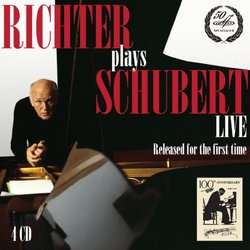| All Artists: Sviatoslav Richter Title: Richter Plays Schubert Members Wishing: 0 Total Copies: 0 Label: Melodiya Release Date: 5/27/2014 Album Type: Box set Genres: New Age, Classical Style: Instrumental Number of Discs: 4 SwapaCD Credits: 4 |
Search - Sviatoslav Richter :: Richter Plays Schubert
 | Sviatoslav Richter Richter Plays Schubert Genres: New Age, Classical The first time I heard him play was at the Moscow Conservatory in May 1957, and he opened his programme with the last of Schuberts sonatas. Its a very long sonata, one of the longest ever written, in fact, and Richter play... more » |
Larger Image |
CD Details
Synopsis
Product Description
The first time I heard him play was at the Moscow Conservatory in May 1957, and he opened his programme with the last of Schuberts sonatas. Its a very long sonata, one of the longest ever written, in fact, and Richter played it at the slowest tempo Ive ever heard. I think at this point its appropriate to confess... Im not really addicted to most of Schuberts music. I find myself unable to come to terms with the repetitive structure, and I get very restless and squirm when I have to sit through one of the longer Schubert essays. What happened was that, for the next hour, I was in a state that I can only compare to a hypnotic trance. All my prejudices about Schuberts repetitive structures were forgotten. Musical details which Id previously considered ornamental were given the appearance of organic elements. In fact, I can remember many of those details to this day. It seemed to me that I was witnessing a union of two supposedly irreconcilable qualities. Intense analytical calculation revealed through a spontaneity akin to improvisation. And I realized at that moment, as I have on many subsequent occasions while listening to Richters recordings, I was in the presence of one of the most powerful communicators the world of music has produced in our time (Glenn Gould). Firma Melodiya has compiled its first album for the 100th anniversary of Sviatoslav Teofilovich Richter from works by Franz Schubert, a composer whose music accompanied Sviatoslav Richter throughout his artistic career (he learnt the Wanderer Fantasie before he entered the conservatory, and the Sonata in five parts, D. 459, was the last piece that Richter worked on in his country house at the end of July 1997 and hoped to play during the forthcoming concert season). The set includes complete phonograms of the concertos of 02.05.1978 (for the 90th anniversary of Heinrich Neuhaus) and 18.10.1978 (for the 150th anniversary of Franz Schuberts death), encores from the concert of 03.05.1978 (the basic programme was similar to that of 02.05.1978), and also the H-Dur sonata (from the concert of 08.06.1979, its second part was dedicated to Sergei Prokofievs music (pleased refer to Mel CD 10 01677) and the c-moll sonata from the concert of 06.10.1971. Ever meticulous about the issues of form of a piece (in particular, he would rigorously perform all the repetitions indicated by the author), Sviatoslav Richter not only performed Schuberts short pieces (landlers, écossaises) in succession, in the order specified by the composer, but after choosing the most congenial of them compiled peculiar miniature suites, sometimes making any other piece adjacent to them. The examples are the suites from the A-Dur piece and four landlers of 02.05.1978, and the suites played as an encore at the concert of 18.10.1978. A listener may also pay attention to the evolution of the form of the E minor sonata, D. 566. The sonata was not finished by Schubert as a whole multi-movement work and is actually a set of individual pieces connected with tonal correlations, a figurative structure and the time when they were composed. In 1953, Richter performed a single-movement version of the sonata. However, later on in the 1950s, he performed a two-movement version (a comparison with Beethovens sonata, Op. 90, inevitably comes to mind). Afterwards, the form grew larger when Richter added the third movement (Scherzo. Allegro vivace), and the fourth one by the 1970s (Rondo. Allegro molto. D. 506) thus performing the version of Paul Badura-Skoda. The sonata is featured in this set twice, as a three- and four-movement version.
